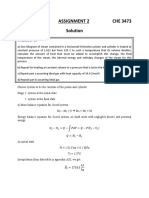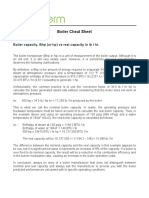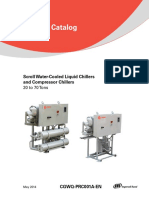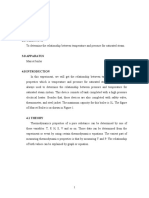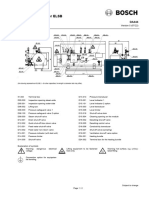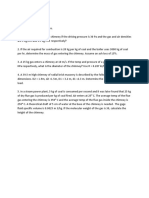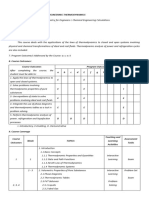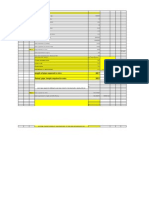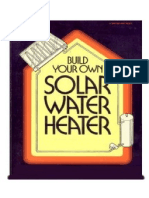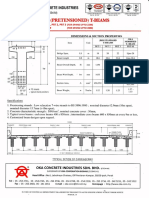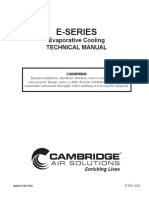Steam Engineering
Steam Engineering
Uploaded by
Tesla DarkCopyright:
Available Formats
Steam Engineering
Steam Engineering
Uploaded by
Tesla DarkCopyright
Available Formats
Share this document
Did you find this document useful?
Is this content inappropriate?
Copyright:
Available Formats
Steam Engineering
Steam Engineering
Uploaded by
Tesla DarkCopyright:
Available Formats
Steam Engineering
1. Introduction
The introduction of steam as a useful and powerful purveyor of energy. It discusses the versatile uses and benefits of this ubiquitous vapour; and the ways in which it is produced and distributed to achieve maximum performance and economy for the end user. 1. 2. 3. Steam - The Energy Fluid Steam and the Organisation The Steam and Condensate Loop
2. Steam Engineering Principles and Heat Transfer
Properties of various types of steam are considered, along with basic heat transfer principles and how to calculate consumption rates for process applications. Entropy is tackled in simple terms, removing unnecessary fears often associated with the subject. 4. 5. 6. 7. 8. 9. Engineering Units What is Steam? Superheated Steam Steam Quality Heat Transfer Methods of Estimating Steam Consumption
10. Measurement of Steam Consumption 11. Thermal Rating 12. Energy Consumption of Tanks and Vats 13. Heating with Coils and Jackets 14. Heating Vats and Tanks by Steam Injection 15. Steam Consumption of Pipes and Air Heaters 16. Steam Consumption of Heat Exchangers 17. Steam Consumption of Plant Items 18. Entropy - A Basic Understanding 19. Entropy - Its Practical Use
3. The Boiler House
Various types of boilers and fuels are discussed, alongside the best ways in which to get the best out of this important part of the steam plant. All necessary associated boiler equipment is considered, including basic deaerator and accumulator theory. 20. Introduction 21. Shell Boilers 22. Water-tube Boilers 23. Miscellaneous Boiler Types, Economisers and Superheaters 24. Boiler Ratings 25. Boiler Efficiency and Combustion 26. Boiler Fittings and Mountings 27. Steam Headers and Off-takes 28. Water Treatment, Storage and Blowdown for Steam Boilers 29. Water for the Boiler 30. The Feedtank and Feedwater Conditioning 31. Controlling TDS in the Boiler Water 32. Heat Recovery from Boiler Blowdown (TDS control only) 33. Bottom Blowdown 34. Water Levels in Steam Boilers 35. Methods of Detecting Water Level in Steam Boilers 36. Automatic Level Control Systems 37. Water Level Alarms 38. Installation of Level Controls
39. Testing Requirements in the Boiler House 40. Pressurised Deaerators 41. Steam Accumulators
4. Flowmetering
Fluid characteristics and flow theory (including Bernoulli's theorem and Reynolds' numbers) are introduced and developed to provide basic metering theory and techniques. Different meter types, instrumentation and installation practice are also discussed. 42. Fluids and Flow 43. Principles of Flowmetering 44. Types of Steam Flowmeter 45. Instrumentation 46. Installation
5. Basic Control Theory
Control theory is discussed from fundamental proportional action to PID control. The dynamic of the simple control loop is discussed, alongside practical issues of choosing the best system for the application, and installation and commissioning issues. 47. An Introduction to Controls 48. Basic Control Theory 49. Control Loops and Dynamics 50. Choice and Selection of Controls 51. Installation and Commissioning of Controls 52. Computers in Control
6. Control Hardware: Electric/Pneumatic Actuation
Control valve capacities and characteristics are investigated, along with theory and practical advice on how to size them for water and steam systems. Actuators, positioners, and controllers are introduced plus their overall effect on the control loop. 53. Control Valves 54. Control Valve Capacity 55. Control Valve Sizing for Water Systems 56. Control Valve Sizing for Steam Systems 57. Control Valve Characteristics 58. Control Valve Actuators and Positioners 59. Controllers and Sensors
7. Control Hardware: Self-acting Actuation
Basic self-acting control theory is discussed, alongside the different types of direct-acting and pilot-operated valves, controllers, and applications for the proper selection of temperature and pressure control of steam and water systems. 60. Self-acting Temperature Controls 61. Typical Self-acting Temperature Control Valves and Systems 62. Self-acting Pressure Controls and Applications
8. Control Applications
A brief summary of, and advice on, temperature, pressure, flow and level control methods to suit various types of steam applications, with consideration to surplussing control, differential pressure control, and cascade control and installation thereof. 63. Pressure Control Applications 64. Temperature Control for Steam Applications 65. Level and Flow Control Applications 66. Control Installations
9. Safety Valves
Arguably, the most important subject in the generation, distribution and use of steam. Why are safety valves required? What different types are available and how are they selected, sized and installed? Other protection devices are also shown in some detail. 67. Introduction to Safety Valves
68. Types of Safety Valve 69. Safety Valve Selection 70. Safety Valve Sizing 71. Safety Valve Installation 72. Alternative Plant Protection Devices and Terminology
10. Steam Distribution
Efficient distribution gets clean dry steam to apparatus at the right pressure. Pipe sizing, essential drainage techniques, pipe support and expansion, air venting, and heat transfer calculations are included to help the system designer and practitioner. 73. Introduction to Steam Distribution 74. Pipes and Pipe Sizing 75. Steam Mains and Drainage 76. Pipe Expansion and Support 77. Air Venting, Heat Losses and a Summary of Various Pipe Related Standards
11. Steam Traps and Steam Trapping
How steam traps work and why steam traps are necessary. All is explained in this block, along with the different types, where they are used, and how they are selected. Air venting theory and applications are touched upon, along with steam trap maintenance. 78. Introduction - Why Steam Traps? 79. Thermostatic Steam Traps 80. Mechanical Steam Traps 81. Thermodynamic Steam Traps 82. Considerations for Selecting Steam Traps 83. Selecting Steam Traps - Canteen Equipment; Oil Transfer/Storage; Hospital Equipment 84. Selecting Steam Traps - Industrial Dryers 85. Selecting Steam Traps - Laundries, Presses 86. Selecting Steam Traps - Process Equipment 87. Selecting Steam Traps - Space Heating Equipment 88. Selecting Steam Traps - Steam Mains; Tanks and Vats; Pressure Reducing Valves 89. Air Venting Theory 90. Air Venting Applications 91. Testing and Maintenance of Steam Traps 92. Energy Losses in Steam Traps
12. Pipeline Ancillaries
These are often neglected to save costs; but strainers, stop valves, check valves, separators, gauge glasses and vacuum breakers all have their part to play in an efficient steam system. This block explains why, and explores the different types available. 93. Isolation Valves - Linear Movement 94. Isolation Valves - Rotary Movement 95. Check Valves 96. Strainers 97. Separators 98. Gauges, Sight Glasses, Vacuum Breakers
13. Condensate Removal
Proper condensate removal is essential to heat exchanger efficiency and long service life. An explanation of how heat exchangers operate. It introduces the subject of stall, and why and how the best trapping device is selected to maximise system efficiency. 99. Heat Exchangers and Stall 100. The Heat Load, Heat Exchanger and Steam Load Relationship 101. Oversized Heat Exchangers 102. Example: Selecting the Trap 103. The Stall Chart - Constant Flow Secondary - Varying Inlet Temperature - Constant Outlet Temperature
104. The Stall Chart - Varying Flow Secondary - Constant Inlet Temperature - Constant Outlet Temperature 105. The Stall Chart - Constant Flow Secondary - Constant Inlet Temperature - Varying Outlet Temperature 106. Practical Methods of Preventing Stall
14. Condensate Recovery
Relaying condensate back to the boiler house reduces costs. Pipe sizing and layout is discussed for drain lines, discharge lines, and pumped lines. The effects of lift and backpressure are explained; and how to reduce overall costs by utilising flash steam. 107. Introduction to Condensate Recovery 108. Layout of Condensate Return Lines 109. Sizing Condensate Return Lines 110. Pumping Condensate from Vented Receivers 111. Lifting Condensate and Contaminated Condensate 112. Flash Steam
15. Desuperheating
Why is it necessary to desuperheat steam? What types of desuperheater exist, where are they used, and how are they installed? Basic types and more sophisticated types of desuperheater and their applications are discussed in some detail. 113. Basic Desuperheating Theory 114. Basic Desuperheater Types 115. Other Types of Desuperheater 116. Typical Installations
16. Equations
A list of all the equations used in the complete set of Steam Engineering Tutorials relating to the subject of how to get the best out of the steam and condensate loop. 117. Equations
You might also like
- A350 AfmDocument836 pagesA350 AfmPunthep Punnotok100% (7)
- Learn About Steam - Spirax SarcoDocument20 pagesLearn About Steam - Spirax SarcoGanesh KulalNo ratings yet
- Steam Table For Saturated Steam: (Continued)Document1 pageSteam Table For Saturated Steam: (Continued)ChristianGuerreroNo ratings yet
- Assignment 2 SolutionDocument3 pagesAssignment 2 SolutionJacob Johnston100% (1)
- Steam Engineering TutorialsDocument7 pagesSteam Engineering Tutorialslanikhil100% (1)
- Forpoling Tunnel PDFDocument12 pagesForpoling Tunnel PDFDilipNo ratings yet
- Basic Questions Related To Thermal EngineeringDocument16 pagesBasic Questions Related To Thermal EngineeringfarukhaliNo ratings yet
- Coolingtowerdryer 140208204949 Phpapp02 PDFDocument22 pagesCoolingtowerdryer 140208204949 Phpapp02 PDFJel SalcedoNo ratings yet
- Exergy Analysis of Organic Rankine CycleDocument9 pagesExergy Analysis of Organic Rankine CycleMukul GoyalNo ratings yet
- Boiler Other Steam Plant AccessoriesDocument5 pagesBoiler Other Steam Plant AccessoriesCollano M. Noel RogieNo ratings yet
- Convection Heat Transfer (Chapter 6)Document25 pagesConvection Heat Transfer (Chapter 6)Ahmad Aiman ZaharinNo ratings yet
- StorkReview PDFDocument128 pagesStorkReview PDFuma shankar balakrishnanNo ratings yet
- CL665 End-Semester Examination Solution: Multiple Choice Questions (1 Mark For Correct Answer, 0 Mark For Wrong Answer)Document8 pagesCL665 End-Semester Examination Solution: Multiple Choice Questions (1 Mark For Correct Answer, 0 Mark For Wrong Answer)Ekta AgrawalNo ratings yet
- Boiler Cheat SheetDocument1 pageBoiler Cheat SheetnicolaskelseyNo ratings yet
- Impulse Turbine and Reaction TurbineDocument5 pagesImpulse Turbine and Reaction Turbinerahul100% (1)
- ML7420A6033, ML7425A6016 (Specification Date)Document4 pagesML7420A6033, ML7425A6016 (Specification Date)Audi eko susatyoNo ratings yet
- CGWQ Prc001a en - 05122014Document28 pagesCGWQ Prc001a en - 05122014amitbslpawarNo ratings yet
- Lab Manual 431Document46 pagesLab Manual 431EDWIN ARLEY DELGADO MURILLONo ratings yet
- Thermal Engineering Lectures1Document120 pagesThermal Engineering Lectures1romasokyNo ratings yet
- Steam Power Plants-IIDocument96 pagesSteam Power Plants-IInaga sNo ratings yet
- Lecture Note - Steam CycleDocument37 pagesLecture Note - Steam CycleSuchi Suchi SuchiNo ratings yet
- Philippine Mechanical CodeDocument118 pagesPhilippine Mechanical CodeRonald Maravilla100% (1)
- Machine Design14 PDFDocument178 pagesMachine Design14 PDFManoy BermeoNo ratings yet
- Power Plant Numerical PDFDocument3 pagesPower Plant Numerical PDFAhsan Ali0% (1)
- Week 06 Ideal Reheat RankineDocument13 pagesWeek 06 Ideal Reheat RankineJohnCris B. FornilosNo ratings yet
- The Calorific Value of A Fuel Is TheDocument4 pagesThe Calorific Value of A Fuel Is TheRana PrathapNo ratings yet
- Experiment 6 Performance of Centrifugal Compressor: A. ObjectiveDocument6 pagesExperiment 6 Performance of Centrifugal Compressor: A. ObjectiveSurjit DuttaNo ratings yet
- Tatyasaheb Kore Institute of Engineering and Technology, WarananagarDocument17 pagesTatyasaheb Kore Institute of Engineering and Technology, WarananagarajayNo ratings yet
- Refrigeration CyclesDocument17 pagesRefrigeration CyclesKhairatun NisaNo ratings yet
- Operator S Guide To General Purpose Steam Turbines - 2016 - PerezDocument27 pagesOperator S Guide To General Purpose Steam Turbines - 2016 - Perezmanashi.barik.2019No ratings yet
- Fan Selection Guide PDFDocument16 pagesFan Selection Guide PDFHarsh KhatriNo ratings yet
- Assignment and Its Solution - Airstandardcycle and VapourcycleDocument24 pagesAssignment and Its Solution - Airstandardcycle and VapourcycleMatthias100% (1)
- Boiler Types and ClassificationsDocument26 pagesBoiler Types and ClassificationshardikNo ratings yet
- Ipe FlyerDocument1 pageIpe FlyerChano ReplanNo ratings yet
- Feed Water & Steam Flow CircuitDocument5 pagesFeed Water & Steam Flow Circuitvamps sier100% (1)
- Flow of Fluids QuizDocument2 pagesFlow of Fluids QuizJhon Oliver De JoseNo ratings yet
- 2012Document8 pages2012sanyasirao1No ratings yet
- Lancashire BoilerDocument6 pagesLancashire BoilerNikhilesh BhargavaNo ratings yet
- Cooling Tower QuestionsDocument2 pagesCooling Tower QuestionsNimantha Narampanawa0% (1)
- Chapter 11 PDFDocument8 pagesChapter 11 PDFVisakan ParameswaranNo ratings yet
- Experiment 1 - Marcet BoilerDocument10 pagesExperiment 1 - Marcet BoilerWee Chuan YeanNo ratings yet
- 3 (A) Thermodynamics RelationsDocument6 pages3 (A) Thermodynamics Relationsananda narayananNo ratings yet
- Energy Balance:: Logarithmic Mean Temperature Difference (LTMD)Document3 pagesEnergy Balance:: Logarithmic Mean Temperature Difference (LTMD)Rae Nikka May PabloNo ratings yet
- Sheet5-Centrifugal PumpDocument5 pagesSheet5-Centrifugal Pumpyousef mohamedNo ratings yet
- Pns Paes 248 2010Document18 pagesPns Paes 248 2010Glaiza Abad FernandezNo ratings yet
- Fourier Series AnalysisDocument23 pagesFourier Series AnalysisVictor DoyoganNo ratings yet
- Chapter 1Document9 pagesChapter 1Prashant JoshiNo ratings yet
- Paes 144 Rice Drum Seeder TestDocument18 pagesPaes 144 Rice Drum Seeder TestFerrer JrNo ratings yet
- Application of Ponding Systems in The Treatment ofDocument10 pagesApplication of Ponding Systems in The Treatment ofbenjiy80No ratings yet
- Law and Code of EthicsDocument53 pagesLaw and Code of EthicsKenn Earl Bringino VillanuevaNo ratings yet
- Experiment No. 1Document4 pagesExperiment No. 1subhamgupta7495100% (1)
- Coaching Problems CFDocument5 pagesCoaching Problems CFDeyn EstoqueNo ratings yet
- Caldera BoshDocument2 pagesCaldera Boshchri.ava20012001No ratings yet
- Homework SteamDocument6 pagesHomework SteamCherry May Basinang-RamosNo ratings yet
- Distillation Column SpecificationsDocument3 pagesDistillation Column SpecificationsPeter John RapanutNo ratings yet
- Thermo SyllabusDocument2 pagesThermo SyllabusRobert DelfinNo ratings yet
- Educspace - Pumps - Problems SetDocument3 pagesEducspace - Pumps - Problems SetMatthew John SyNo ratings yet
- Assignment - Condenser and Nozzle-1Document2 pagesAssignment - Condenser and Nozzle-1Harshil ChaddhaNo ratings yet
- Introductory Applications of Partial Differential Equations: With Emphasis on Wave Propagation and DiffusionFrom EverandIntroductory Applications of Partial Differential Equations: With Emphasis on Wave Propagation and DiffusionNo ratings yet
- Hydrogen Production TechnologiesFrom EverandHydrogen Production TechnologiesMehmet SankirNo ratings yet
- Steam Engineering TutorialsDocument208 pagesSteam Engineering Tutorialsaecsuresh35No ratings yet
- Prelim Exam - Ote, Raisah C.Document14 pagesPrelim Exam - Ote, Raisah C.Rayz C.ONo ratings yet
- Crear Web Services Usando SAP NET ConnectorDocument15 pagesCrear Web Services Usando SAP NET ConnectorXurand Gomez ZarateNo ratings yet
- Astm F 732: - ScopeDocument16 pagesAstm F 732: - ScopeSagar DhageNo ratings yet
- Simulation Project ProposalDocument1 pageSimulation Project ProposalAleksandr ZenkovNo ratings yet
- Digital Summer Pack Grade IVDocument33 pagesDigital Summer Pack Grade IVhamzasandhu15387No ratings yet
- Lab 1: Analysis and Planning: Subject: Software EngineeringDocument6 pagesLab 1: Analysis and Planning: Subject: Software EngineeringDuy ĐỗNo ratings yet
- Steam Coil DesignDocument2 pagesSteam Coil DesignHendri SinagaNo ratings yet
- Pe Tutorial 6 PDFDocument12 pagesPe Tutorial 6 PDFkibrom atsbhaNo ratings yet
- ABB TPL 65 Turbochargers - Torsional Vibration of RotorDocument4 pagesABB TPL 65 Turbochargers - Torsional Vibration of Rotorartemio CardosoNo ratings yet
- Equipment-Profile Report 280222Document81 pagesEquipment-Profile Report 280222PabloGarciaNo ratings yet
- Hyundai 130w 3 HydDocument2 pagesHyundai 130w 3 Hyddwight100% (62)
- FS 3 Technology in The Learning EnvironmentDocument24 pagesFS 3 Technology in The Learning EnvironmentJayson Gelera CabrigasNo ratings yet
- Build Your Own Solar Water HeaterDocument115 pagesBuild Your Own Solar Water HeaterMoreMoseySpeed100% (5)
- Ornithopter With Live Video Reception For Military SurveillanceDocument4 pagesOrnithopter With Live Video Reception For Military Surveillancechandana soojiNo ratings yet
- Boomer 282 - 8999 4039 00Document1,004 pagesBoomer 282 - 8999 4039 00JAIR ARIEL VIVERO SILVA100% (1)
- FCC OIC Report On Debunked DDoS AttackDocument106 pagesFCC OIC Report On Debunked DDoS Attackjonathan_skillingsNo ratings yet
- Littelfuse Hall Effect Sensors 55140 Datasheet PDFDocument3 pagesLittelfuse Hall Effect Sensors 55140 Datasheet PDFNicacio LucenaNo ratings yet
- Schematy Ektryczne Voyager Roczniki 96-00Document67 pagesSchematy Ektryczne Voyager Roczniki 96-00Stefan JarockiNo ratings yet
- BAHARUDocument20 pagesBAHARUcrysNo ratings yet
- 2023 Will Be A Year of Transition and Strategy For Businesses WorldwideDocument6 pages2023 Will Be A Year of Transition and Strategy For Businesses Worldwideyektakarami97No ratings yet
- Oka JKR T-Beams - M-BeamsDocument2 pagesOka JKR T-Beams - M-Beamsrobert ongNo ratings yet
- Examen BorjaDocument7 pagesExamen BorjaAna Leiva SanchezNo ratings yet
- Shear Vane Guidelines PDFDocument11 pagesShear Vane Guidelines PDFstavros_stergNo ratings yet
- E-Series Evap Tech Manual 1-19Document16 pagesE-Series Evap Tech Manual 1-19AANo ratings yet
- About Us SaintgitsDocument10 pagesAbout Us Saintgitshari narayananNo ratings yet
- C 0024 - TLZ THLZ - 04 08Document46 pagesC 0024 - TLZ THLZ - 04 08Oscar Alvitez DominguezNo ratings yet
- ETL Yanmar Gartenhacke TE 30Document28 pagesETL Yanmar Gartenhacke TE 30abdelfatteh ameurNo ratings yet
- Section 1 GeneralDocument5 pagesSection 1 GeneralAndré TarginoNo ratings yet
- Base NH BussmannDocument7 pagesBase NH BussmannMiguel Guillermo Zelaya DamianNo ratings yet



